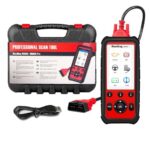When upgrading or replacing fuel injectors in your Honda, you might encounter discussions about OBD1 and OBD2 injectors. It’s a common misconception that the OBD generation is the primary factor determining injector compatibility or performance. However, the crucial aspect you need to understand is the difference between high resistance (saturated) and low resistance (peak & hold) injectors. Confusing these two can lead to serious issues, potentially frying your fuel injection system. Let’s clarify the real distinctions.
The initial confusion often stems from the connectors. OBD1 and OBD2 Hondas frequently use different injector connector types. This is a physical difference, but it’s superficial compared to the electrical characteristics of the injectors themselves. The core issue isn’t the connector, but rather the injector’s resistance and the type of electrical signal it requires to operate correctly.
There are fundamentally two types of fuel injectors in terms of their electrical operation:
-
Saturated Injectors (High Resistance): These injectors are designed to be continuously powered with a lower current. They have higher internal resistance and are simpler to control electronically. Most Hondas, especially older models, are originally equipped with saturated injectors.
-
Peak & Hold Injectors (Low Resistance): These injectors utilize a more complex control strategy. They receive a short, high-current “peak” signal to rapidly open the injector, followed by a lower “hold” current to keep it open. This allows for faster response times and more precise fuel delivery, often beneficial for performance applications requiring larger injectors. However, they draw significantly more current initially.
The danger arises when you mismatch injector types with your car’s fuel injection system. Specifically, installing low resistance peak & hold injectors into a system designed for high resistance saturated injectors will overload and potentially damage your ECU (Engine Control Unit) or fry the injectors themselves.
This is why a “resistor box” is often necessary when upgrading to peak & hold injectors on older Hondas originally equipped with saturated injectors. For instance, if you’re upgrading a Honda Integra (Teg) designed for saturated injectors and you opt for higher-flowing, low resistance injectors, you’ll need a resistor box. The resistor box effectively adds resistance into the circuit, mimicking the electrical load of saturated injectors and protecting the ECU.
Let’s consider some concrete examples with Honda Prelude injectors:
-
OBD1 Prelude Injectors (345 cc/min): These are peak & hold (low resistance) injectors. If you were to install these on a system designed for saturated injectors without a resistor box, you would risk electrical damage, not because they are OBD1, but because they are low resistance.
-
OBD2 Prelude Injectors (290 cc/min): These are saturated (high resistance) injectors. They are electrically compatible with systems designed for saturated injectors without needing a resistor box.
Notice that both OBD1 and OBD2 injectors exist, and the crucial difference is not the OBD generation, but the injector type (peak & hold vs. saturated) and their resistance. OBD1 is simply a generation of onboard diagnostics and engine management systems, and OBD2 is a later, more standardized generation. Injector technology exists across both generations.
Similarly, larger 450 cc/min Mitsubishi injectors, often used for Honda performance upgrades, are also typically peak & hold (low resistance). They too require a resistor box when installed in systems designed for saturated injectors.
Therefore, when choosing Honda injectors, especially when considering OBD1 or OBD2 options, remember these key takeaways:
-
OBD1 vs. OBD2 connectors are a separate issue from injector resistance. You can adapt connectors if needed, but electrical compatibility is paramount.
-
Peak & Hold (low resistance) vs. Saturated (high resistance) is the critical distinction. Mismatched resistance can cause electrical damage.
-
Always determine the type of injectors your car’s system is designed for (saturated) and the type of injectors you are considering installing.
-
If upgrading to low resistance peak & hold injectors on a system designed for saturated injectors, use a resistor box to protect your ECU.
Choosing saturated injectors for upgrades can simplify the process as they are generally a direct electrical replacement in systems designed for them, eliminating the need for a resistor box. However, saturated injectors might not be available in the larger flow rates required for high-performance applications, which is where peak & hold injectors become necessary, along with the proper supporting modifications like a resistor box.
In conclusion, while the terms OBD1 and OBD2 are often mentioned in discussions about Honda injectors, focus on understanding whether the injectors are saturated (high resistance) or peak & hold (low resistance). This electrical characteristic is the determining factor in compatibility and system safety, far more important than the OBD generation of the connector. Always ensure you match the injector type to your vehicle’s fuel injection system or implement the necessary modifications, like a resistor box, to prevent electrical damage and ensure proper engine operation.
